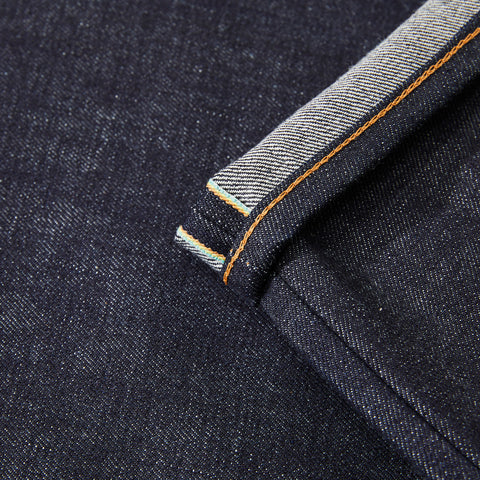All About "EDS" Jeans
Traditional Japanese denim made of NIHON MENPU fabric, full of the identity of EDWIN.

Compared to modern looms, the width of denim woven on old shuttle looms is narrower and the weaving speed is much slower. However, the slow weaving of the denim on the old shuttle looms gives the denim its characteristic unevenness and fullness. The weft of the denim is made from a blend of HAKUSHU cotton, a rare Japanese cotton that has been cultivated since the Edo period (1603-1868), giving the denim a more elastic finish than usual.
The selvedge on the edge of the fabric is also rainbow-colored, the same as that of EDWIN's first domestic jeans 359BF model released in 1963. The identity of the company has been preserved since its foundation. The selvedge denim is more expensive than other denim due to the lack of production efficiency and fabric availability, but it is worth it to enjoy the fading that is the real appeal of jeans.
Sewing technology supported for many years of experience

Sewing techniques backed up by years of experience
EDWIN manages the entire process from fabric to finished product in its own factories.
For the EDS series, the entire process from cutting to sewing is carried out at "Akita Hose" in Gokome, Akita Prefecture, which is the oldest of the company's factories and where the origins of EDWIN's manufacturing reside. Using various sewing machines and automatic machines developed and customized exclusively for EDWIN, the company stubbornly keeps its "secret" promise to every detail of its products. There is no compromise on quality, not even a little. The mastery of our Akita-based staff and our strict quality standards are the backbone of Edwin's Made in Japan pride.
Commitment details

While incorporating authentic details that are typical of jeans, EDWIN's commitment is to maintain the quality of jeans that can be worn for a long time.
For the sewing thread, we use a high-strength polyester filament yarn called "S-core yarn" as the core, and cover it with high quality cotton. This gives the garment a faded look, while maintaining its strength for a long time.
The leather label is made of nubuck leather, which becomes darker and more lustrous as it is used. You can enjoy the change of the leather label as well as the denim fabric.
The belt loops have an offset center loop. This detail is typical of vintage denim from the 1930s and 1950s.
Offering the best size range of LENGTH

The jeans, which are only available in concept shops, are offering two or three different lengths (inseam length) in the same silhouette.
If you wear a pair of jeans that are hemmed up and out of knee position, it will look unbalanced and ruin your silhouette. By offering different lengths, you can find a pair that suits your length and the way you wear them (rolled up, for example).
In addition, the hems of used jeans are also treated to look like they have been worn and frayed over time, but only the hems will look new if they are hemmed.
It is not efficient to have different lengths of the same pair of jeans, but we do it because we want our customers to be satisfied with their jeans.
EDS series that enjoys aging.
HINOMARU wash.

The beauty of denim is in the way it fades with age.
The color fades in different ways for different people. The color fades differently for each individual, reflecting the shape of your body and your daily routine, making your denim your own. We want you to wear them from the raw, unwashed finishing and make them your own.
The EDS series comes with a "Hinomaru Leather Tag" which can be worn in the coin pocket to reveal the "Hinomaru Wash". This fading is the hallmark of the EDS series.
(The photo shows the EDS Regular Tapered which our staff have worn for 2 years)